Saint of the Day
Summary: Saint Catherine of Siena
Mary O’Driscoll OP has lectured on St Catherine of Siena in many countries, finds messages for today in the great saint’s life and writings.
One of the characteristics of contemporary spirituality is a return to classical sources for light and nourishment on our own journey as Christians. In this short reflection I would like to share some thoughts on the spirituality which is offered to us by one of the greatest mystics in the Christian tradition, Catherine of Siena, for I believe strongly that she has much to say that is relevant for today’s Christians.
Remarkable Christian Woman
Catherine of Siena was a remarkable Christian woman. She stands out not only in her historical period, but also in succeeding centuries, as a colourful, strong, passionate and enthusiastic personality. She was a woman who had a tremendous zest for life and who put all of herself into whatever she was convinced about. One of her biographers describes her as someone who was always ‘at full stretch’, whether she was responding whole-heartedly to her loving God or reaching out compassionately to her needy neighbour.
Time of great change
Catherine Benincasa (to give her actual name) was born in Siena in Italy in 1347. The fourteenth century in which she lived bears many resemblances to our own twentieth century. In fact, our century is seen by many as “distant mirror” of Catherine’s century. (See for example, Barbara Tuchman, A Distant Mirror, Macmillan, 1978). Both periods are characterized by great cultural, economic, political, religious and social changes with all the insecurity, confusion and upheaval that go with such changes. Catherine, through her life and writings, was clearly able to speak to her contemporaries of the fourteenth century in relevant and helpful ways, so there is a good chance that she can speak to us too.
Doctor of the Church
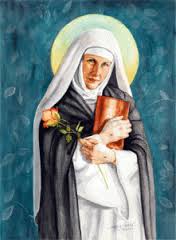 Another reason for seeking a suitable Christian spirituality for ourselves today from Catherine of Siena has to do with the fact that in our own century she has been named a doctor of the Church.
Another reason for seeking a suitable Christian spirituality for ourselves today from Catherine of Siena has to do with the fact that in our own century she has been named a doctor of the Church.
In 1970 Pope Paul VI, conferred this title on her and on Teresa of Avila. This was an extraordinary occurrence. The title, doctor of the church has been conferred on relatively few (34) christian theologians in the course of church history, and on no woman before 1970. The significance of this declaration is immense, for it places two women mystics among the major church theologians, thereby recognizing their ecclesial role as teachers whose doctrine is relevant for the whole church and for all time. By declaring in our time the laywoman, Catherine of Siena, a doctor of the church, Paul VI was surely recognizing not only that her theological teaching is authentic and therefore contributes to our understanding of revelation, but also that she has something worthwhile to say to our age.
Literary vitality
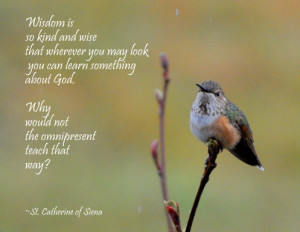 Catherine’s spirituality was lived out day by day in her life, and she offers us its main dimensions in her writings, particularly in her mystical experience of God, and her own understanding of what the Christian life is about.(See Suzanne Noffke, The Dialogue, Paulist Press 1980). One of the attractions of Catherine’s writings is her style which is spontaneous, energetic and passionate. Her literary vitality comes in great measure from her superb use of imagery. She uses images in her efforts to communicate her inexpressible experience of the most profound realities, and hopes that these images will stimulate the dormant intuition of her readers opening up for them a deeper meaning of human and divine truths. Her images come from the ordinary things and experiences of her life:
Catherine’s spirituality was lived out day by day in her life, and she offers us its main dimensions in her writings, particularly in her mystical experience of God, and her own understanding of what the Christian life is about.(See Suzanne Noffke, The Dialogue, Paulist Press 1980). One of the attractions of Catherine’s writings is her style which is spontaneous, energetic and passionate. Her literary vitality comes in great measure from her superb use of imagery. She uses images in her efforts to communicate her inexpressible experience of the most profound realities, and hopes that these images will stimulate the dormant intuition of her readers opening up for them a deeper meaning of human and divine truths. Her images come from the ordinary things and experiences of her life:
*a fire eagerly consuming the wood thrown on it,
*light filtering through a narrow street,
*a tall tree laden with fruit,
*bridge across a river, the mirror in which she sees her own reflection,
* a vineyard, the vast ocean with its peaceful surface.
This last image is a favourite of Catherine’s. In one place in The Dialogue she prays:
“You, Eternal Trinity, are a deep sea. The more I enter you, the more I discover, and the more I discover, the more I seek you”.
Self-knowledge
The context in which Catherine develops her theology and spirituality is self-knowledge. This is very interesting. Her first theological question is therefore, not “Who is God?” but “Who am I?” This question, “who am I?” is a haunting question for people today. In our time, more and more people speak of an emptiness within themselves, a sense of meaninglessness in their lives. “Who am I?” or “What is the meaning of my life?” can at times become a terrifying, tormenting question. Most of us will have asked ourselves this question in one way or another, at one time or another in our lives. The times we question the meaning of life or our identity or worth are usually not the times when we feel everything is going well or when we are successful or feel good about ourselves, but rather when we have to cope with failure or sickness or loneliness or rejection or despair. In her writings Catherine of Siena shows that she is aware of such moments, and it is through them that she begins her quest for self-knowledge.
In seeking knowledge and understanding of ourselves, Catherine explains that we will never find these if we keep looking only at ourselves. Rather, in order to know who we are or what the meaning of our lives is, we need to go to the One who made us. Einstein declares, “If a person finds a satisfying answer to the question ‘what is the meaning of life?’ that person I would call religious”. Catherine of Siena would agree. In stating that we need to look at God in order to know who we are, she is not however offering an easy way out of the question but rather showing her appreciation of the fact that, although we can come quite far in understanding ourselves by looking at ourselves, we can never arrive at the deepest, richest self-knowledge without seeing ourselves through God’s eyes, or, as she puts it, without gazing at ourselves in the “gentle mirror” of God. Catherine’s God is always gentle just as the God Jesus tells us about in the gospels is gentle. The reason we can see ourselves in our gentle God is that we are made in the divine image.
Not afraid of the dark
The process or growing in self-knowledge is compared by Catherine to digging a well. If we want to make or uncover a well we need to dig through much soil, even stones at times, before we reach the running water. Likewise in coming to know ourselves, we come in touch with our own inadequacies, imperfections, failures, limitations. These are what Catherine calls “the soil of our poverty“. She encourages us not to be afraid to go down this well, that is, not to run away in fear or disgust from that part of ourselves which is dark, frail or imperfect. Rather, she encourages us to stay with it, for it reminds us of an important truth about ourselves, namely, that as created beings, we have to accept that limitations and inadequacies are built into our human condition. This however is not a depressing discovery; rather, in becoming aware of our failures and incompleteness, we become aware also of our need for God, the running water at the bottom of our well, and we begin to stretch out and reach down towards this bubbling source of life within us. We are like the deer that yearns for running streams (Ps.42), or like the dry, weary land that longs for water (Psalm 63). At the bottom of our well, at the centre of our being, therefore, where we best know who we are as limited human beings, we rejoice in God who is All, and it no longer matters (in fact it is an advantage) that we are small, frail, imperfect.
That is one part of the answer to the question, “who am I“? – the part that puts me in touch with the truth that I am a creature and not the creator (and in that sense, I am, in Catherine’s words, “the one who is not“). There is however another side to who I am, namely, that I am of tremendous worth and have extraordinary dignity. To do justice to Catherine of Siena’s teaching on self-knowledge, we need to reflect also on this.
God’s love
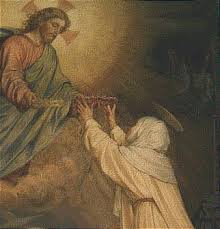 When we look at ourselves in God’s “gentle mirror“, the first truth that we discover is that we are loved. Catherine never ceases to be amazed at the depth and extent of God’s love for us. This is expressed above all in Creation and Redemption. Explaining God’s creative love, she prays: “With indescribable love you looked at us within your very self, and you fell in love with us. So it was love that made you create us and give us being”. (Dialogue 13)
When we look at ourselves in God’s “gentle mirror“, the first truth that we discover is that we are loved. Catherine never ceases to be amazed at the depth and extent of God’s love for us. This is expressed above all in Creation and Redemption. Explaining God’s creative love, she prays: “With indescribable love you looked at us within your very self, and you fell in love with us. So it was love that made you create us and give us being”. (Dialogue 13)
There is no other reason for our existence except God’s love. Catherine pictures God addressing her as “my dearest daughter whom I love so very much”. God wants to tell each of us, too, of the extent and depth of divine love. If Catherine of Siena is amazed by God’s love in creating us, she is more staggered by the even greater manifestation of that love in the Incarnation. Trying to fathom God’s redemptive love, which comes to us through Jesus Christ, she asks: “Do you need your creature? It seems so to me, for you act as if you could not live without her. She runs away from you and you go looking for her. Why are you so mad?” (Dialogue 153)
Yes, in looking at myself in God, I can say with absolute certainty, “I am loved”. The knowledge and experience of being loved gives us the freedom to love others freely and sends us out into our world, as nothing else can, to share our love with others.
Beauty
Looking at ourselves in God, our “gentle mirror”, we also realize how beautiful we are. Here we are reminded of the statement in Ephesians: “you are God’s work of art” (Eph. 2:10). Catherine’s spirituality, more than that of many others, stresses the beauty of the human person. That beauty comes about first of all because we are made in the image of God who is “beauty beyond all beauty”. At the beginning of The Dialogue, Catherine receives the invitation: “Open your eye and gaze into me and you will see the dignity and beauty of human persons” (Dialogue 1). She would say that all the magnificent and breath-taking beauty which is disseminated in the natural world is surpassed by the beauty of the human person made in God’s image and redeemed by Jesus Christ. Some of us find it hard to believe in our own beauty; that may be because we are not looking into the gentle mirror that is God to know who and what we are. Others find it hard to see beauty in some people who do not appeal to them. Here the advice God gives to Catherine is relevant: when you see something you do not like in a person, “pluck the rose from the thorns” (Dialogue 100) Many people in our world today have no sense of their own beauty and dignity. Our task as christians is to try to bring them to a realization of who and what they are.
We see from our reflection that self-knowledge, in the sense in which Catherine uses the term, is not a morbid or depressing introspection. It is rather a knowledge of ourselves which we gain by gazing contemplatively at the gentle God who created us. “I am loved, I am beautiful”, we can all say with absolute conviction. This conviction is our best antidote to the materialism and sense of meaninglessness which have such a stranglehold on our twentieth century existence.
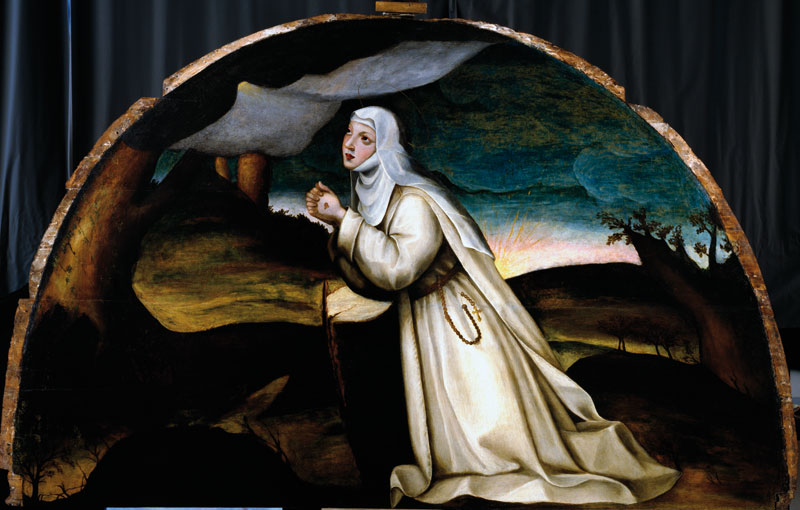
This article first appeared in Spirituality (July/August 1995), a publication of the Irish Dominicans.
Summary : St Catherine was a remarkable woman in Renaissance Italy. She refused her parents’ arrangements for her to marry and went into isolation for three years. She gathered a huge following of friends and disciples. She persuaded the Pope to come back from Avignon to Rome and gave herself in service of the Church and the poor.
Patrick Duffy tells her story.
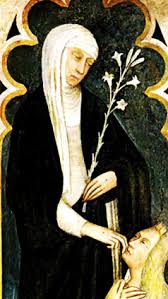 Catherine was born in 1347, the youngest daughter of a prosperous Sienese wool-dyer, Giacomo Benincasa. A lively good-looking girl, in adolescence she became attracted to prayer and solitude, resisted her parents’ attempts to get her to marry, cutting off her beautiful golden hair.
Catherine was born in 1347, the youngest daughter of a prosperous Sienese wool-dyer, Giacomo Benincasa. A lively good-looking girl, in adolescence she became attracted to prayer and solitude, resisted her parents’ attempts to get her to marry, cutting off her beautiful golden hair.
Three Years’ Isolation and a Mystical Marriage
Catherine joined the third order of St Dominic, wore the black and white habit but stayed at home. For three years she never left her room, except to go to Mass and confession, and spoke to no one except her confessor. “My cell will not be one of stone,” she said, “but one of self-knowledge.”
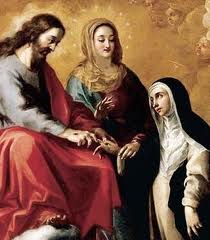 She received a vision of Christ, who told her: “Know, daughter, that I am He who is, and you are that which is not.” From this she developed her sense of her vocation and her spiritual life. She trained herself to live on a spoonful of herbs a day and a few hours’ sleep every night. On Shrove Tuesday 1367 while the town of Siena celebrated Carnivale, she remained praying in her room where she experienced a mystical marriage with Jesus. Jesus appeared to her and placed a ring on her finger, visible only to herself.
She received a vision of Christ, who told her: “Know, daughter, that I am He who is, and you are that which is not.” From this she developed her sense of her vocation and her spiritual life. She trained herself to live on a spoonful of herbs a day and a few hours’ sleep every night. On Shrove Tuesday 1367 while the town of Siena celebrated Carnivale, she remained praying in her room where she experienced a mystical marriage with Jesus. Jesus appeared to her and placed a ring on her finger, visible only to herself.
A Following – ‘Caterinati’
After three years she resumed her share of the housework at home and began to mix with other people, first through nursing the sick and helping the poor. She soon had a following – men and women, friars and priests – attracted as much by her gifts of discernment and asceticism as by her lively personality and personal charm. The people of Siena, puzzled by all this coming and going around a young woman with a reputation for holiness, called them the ‘Caterinati’, of “Catherine followers”. Affectionately they called her Mama.
Call as peacemaker
In 1370 she experienced a kind of mystical death with a vision of hell, purgatory and heaven followed by a divine call to enter the public life of the world. She began dictating letters through secretaries to contending parties in disputes advising them on the performance of their duties. She never learned to write herself until quite near her death. At first she served as a local peacemaker, mediating between feuding families in Siena. But soon she was called to make peace in the armed conflict between the city of Florence and the Avignon-based papacy.
 The Popes had been in Avignon since 1309 and were strongly under the influence of France. The Italian cities were at strife with the French papal legates. When Florence declared war on the papal states in protest against the legates’ rule, eighty towns joined them in ten days. While Catherine was in Pisa, working in the cause of peace, she received the stigmata on the fourth Sunday of Lent, 1375, although the marks remained invisible until after her death.
The Popes had been in Avignon since 1309 and were strongly under the influence of France. The Italian cities were at strife with the French papal legates. When Florence declared war on the papal states in protest against the legates’ rule, eighty towns joined them in ten days. While Catherine was in Pisa, working in the cause of peace, she received the stigmata on the fourth Sunday of Lent, 1375, although the marks remained invisible until after her death.
At Avignon
At a certain stage in this war, Florence asked Catherine to go to Avignon to intercede with Pope Gregory XI on behalf of their embassy. She agreed and went with twenty-three members of the ‘bella brigata’, including four priests, to Avignon arriving in May, 1376 where she stayed for four months.
It was a difficult time for Catherine. The prelates of the inquisition harassed her with examinations in doctrine; the women of power made fun of her and the Florentine ambassadors did not accept her mediation. But Pope Gregory XI listened to her. She understood the irresolution of his character and finally succeeded in getting him to do what he had already decided in his heart he ought to do i.e. go to Rome.
The Papacy Restored to Rome
Pope Gregory XI left Avignon for Rome the following September, but died within a year. The Romans rioted, demanding a Roman pope. The cardinals elected a Neapolitan, Urban VI, who soon proved so arrogant, over-zealous and prone to violent outbursts of temper that the French and other cardinals regretted their action. But failing to persuade him to resign, they withdrew to Anagni and elected a second, in fact an anti-pope, who went to live in Avignon, Robert of Geneva (Clement VII), thus starting the great western Schism which lasted for the next forty years.
Loyal to the Belligerent Urban VI
Catherine remained loyal to the belligerent Urban VI and at his request went to Rome to work to restore unity. She frequently wrote letters to him urging him to moderate his harshness and to various European leaders and the cardinals to whom she pleaded to recognise him as the authentic pope. But she felt the wound in the body of Christ could only be healed by a great sacrifice.
Her Death and Influence
One evening in January, 1380, while dictating a letter to Urban, she suffered a stroke. It seemed as if the church, like a mighty ship, was placed on her back. She had a second stroke while at prayer in St. Peter’s and died three weeks later on April 29th, 1380, aged thirty-three. She was buried under the high altar in the Dominican church of ‘Santa Maria sopra Minerva‘, but her head was afterwards removed and taken to Siena, where it is enshrined in the Dominican church. Her friend, Raymond of Capua, later Master General of the Dominicans, wrote her life, which was influential in leading to her canonisation in 1461 by the Sienese Pope Pius II (Enea Silvio Piccolomini).
Writings
Before leaving Siena for the last time, she dictated a book called The Dialogue of St. Catherine; this and her four hundred Letters comprise a great treasury of spiritual writing.
Doctor of the Church
In 1970 Pope Paul VI named St Catherine of Siena, along with St Teresa of Avila, “Doctor of the Church”.
Summary: Saint Robert of Molesme (c. 1028 – 1111) was a Christian saint and abbot, one of the founders of the Cistercian Order in France.
Patrick Duffy reviews his life.
Early life as a Monk
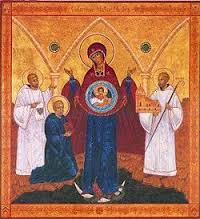 Robert was a member of the nobility in Champagne, a younger son, who entered the abbey of Montier-la-Celle, near Troyes, at the age of fifteen and later became prior. The image (left)<<< shows Robert of Molesme, Alberic and Stephen Harding venerating an image of Mary.
Robert was a member of the nobility in Champagne, a younger son, who entered the abbey of Montier-la-Celle, near Troyes, at the age of fifteen and later became prior. The image (left)<<< shows Robert of Molesme, Alberic and Stephen Harding venerating an image of Mary.
Made Abbot
He was made the abbot of Saint Michel-de-Tonnerre soon after the year 1060, but he was unable to reform the abbey, which had become known for its laxity, and so he returned to Montier-la-Celle.
Founding of Molesme
Some hermits living in the forest of Colan sought Robert out there and asked to be put together under his direction in a new monastery. He got the permission of Pope Gregory VII to found a monastery at Molesme in Burgundy in 1075. At first, they had only huts made of branches surrounding a chapel dedicated to the Holy Trinity in the forest. Molesme Abbey quickly became known for its piety and sanctity, and Robert’s reputation as a saintly man grew. But when the house grew wealthy, new, unsuitable monks came to the area and divided the brothers, challenging Robert’s severity. Robert twice tried to leave Molesme and was ordered back by the Pope.
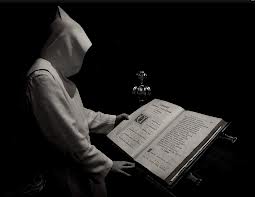 Founding of Citeaux
Founding of Citeaux
However, in 1098 Robert and several of his monks left Molesme with the intention of never returning. Renaud, the viscount of Beaune, owned a desolate valley in a deep forest, which he gave to Robert and his companions, and thus they founded the Cistercians. Cistercium is the Latin name for the village of Cîteaux, near Dijon in eastern France, where they made their foundation. Stephen Harding and Saint Alberic, two of Robert’s monks from Molesme, were pivotal in founding the new house, as Robert ended up staying for only a year.
Return to Molesme
In 1100, the monks of Molesme asked Robert to return and they agreed to submit entirely to his interpretation of the Rule of St. Benedict. He did return and ran the monastery according to his own interpretation and example. Molesme became a major center for the Benedictines under his leadership.
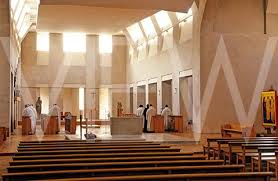 Citeaux continues
Citeaux continues
Meanwhile, the monastery at Cîteaux, under the direction of Alberic, and especially Stephen Harding, became the cornerstone for the new Cistercian Order, which grew to greater fame in the 12th century when Bernard of Clairvaux arrived with thirty-five of his relatives and friends to join the monastery.
Death and Canonisation
Robert continued at Molesme until he died in 1111. Pope Honorius III canonised him in 1220.






















